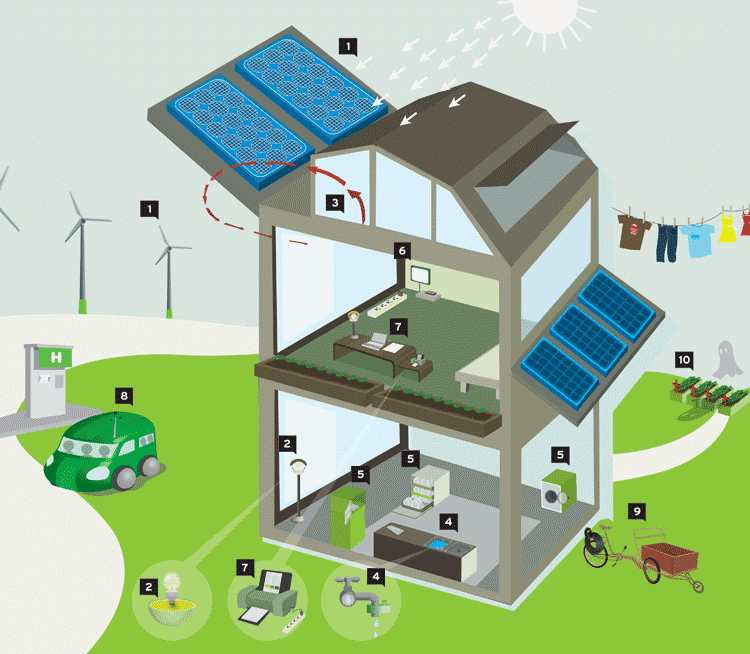
The Incredible Shrinking Footprint
You don’t have to go broke on gadgets or move to a commune to go green. Here are a few easy tips for saving the planet—and lots of cash.1. You may not be ready to invest in home solar panels, but switching to green power now adds less to your monthly bill than the cost of one Starbucks tall chai latte. Most electric companies offer green energy options, such as Consolidated Edison Company of New York's Green Power, a mix of wind and hydropower, which helps an average household reduce annual carbon dioxide emissions by about the amount that a car spews over 5,325 miles—almost a roundtrip drive from New York to Los Angeles. TOP
2. Everyone's talking about how compact fluorescent lightbulbs use two-thirds less energy and last up to 10 times longer than regular bulbs. But have you actually replaced the ones in your home? We thought not. Switching five regular lightbulbs with CFLs can save $60 a year. If every U.S. household did it, we'd save a trillion pounds of greenhouse gases. TOP
3. Heating and cooling account for 50 to 70 percent of the energy used in the average home, so turn off Extreme Makeover: Home Edition and weatherproof your house! Weather stripping or caulking drafts around windows and doors can save a household of four more than 30 percent, or almost $500 a year, on utility bills. TOP
4. To get your eight glasses a day you could buy three bottles of water at your local Kwik- E-Mart—or just attach a filter directly to your faucet. A filter lasts four months and costs about $20 to replace, which equals an annual savings of up to $3,000—and a whole lot of plastic. TOP
5. Energy Star appliances gobble half as much energy and water as standard models, and if one in 10 U.S. households used them, the greenhouse gas emissions saved would eventually be equivalent to planting 1.7 million acres of trees— minus the backache. TOP
6. While you're out, your electronics don't just go to sleep—they're up, sucking energy. Electronics in standby are responsible for one percent of the world's carbon dioxide emissions. To make sure TVs, cell phone chargers, stereos, and more are off the grid while you're away, hook them up to outlet timers or power strips that can be turned off in one flick. TOP
7. Don't forget to green your home office. By design, laptops use up to 50 percent less energy than desktops, and inkjets use up to 90 percent less than laser printers. TOP
For more information on how to use less, visit www.energystar.gov.
CAR8. Cars generate almost 1.1 billion tons of carbon dioxide emissions each year, and with the national average gas price hovering around $3 per gallon, cutting your consumption could mean more green for the environment— and your wallet.
-
Hybrid cars can reduce smog by 90 percent and significantly cut down how much you pay at the pump. A 40-mile roundtrip commute to work in a hybrid will average $500 in gas each year but can cost three times that in a standard SUV. An added bonus: For a limited time, newly purchased hybrids can earn more than $3,000 in tax credits.
If you're not ready for a hybrid, buying a car that gets 30 mpg instead of 20 can save $3,750 in fuel costs over five years—and even more if gas prices continue to rise.
If 1,000 people shared their 20-mile round-trip commute with just one other person, it would save almost 20,000 pounds of carbon dioxide and about $3,000 in gas each day—so hop on the bandwagon (literally) to get your share. TOP
9. Consider riding a bicycle for shorter commutes or taking public transportation when it's available. Leaving your car in the garage just two days a week will reduce your greenhouse gas emissions by about 1,600 pounds each year. TOP
To find out more about saving money on gasoline, visit www.fueleconomy.gov.
AFTERLIFE10. Each year, Americans inject the planet with more than 800,000 gallons of embalming fluid and more than 180,000,000 pounds of nondegradable steel caskets, which create considerable waste to produce. Cremation is no better: You could fly to the moon and back 83 times on all the energy used for cremations in one year. To make your last act on this Earth one that will benefit it, reserve a plot at a green burial ground, where your biodegradable wooden or cardboard casket helps reduce afterlife pollution. At roughly $2,500, a green funeral also costs about half that of a conventional one. TOP
To learn more about green funerals, visit www.naturalburial.org.
Illustration © Futurefarmers/Amy Franceschini







